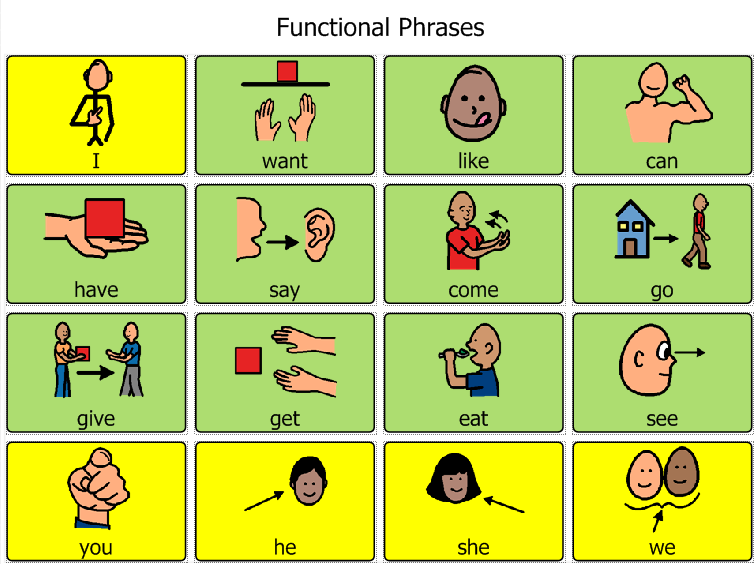A question I am frequently asked as a speech-language pathologist who works with a large caseload of students with Down syndrome (DS) is, “What are some strategies you use to develop language and articulation skills in children with DS?” This is a loaded question, since the abilities of children with DS vary greatly. Before considering strategies, we need to conduct an appropriate language and speech assessment for each child. After this is completed, we can write goals and come up with a treatment plan. For detailed information about how to conduct articulation and language assessments for children with DS, consult the following resource: Assessment Guide for Children with Down Syndrome
Once an assessment is conducted, targets can be selected. For verbal students with DS who need to increase their utterance length and vocabulary, I write goals that require them to utilize high frequency functional phrases. These students make up the bulk of my caseload. They benefit from recurrent opportunities to use common utterances that will help them participate in school and get their needs met when necessary. An additional consideration for my students is that they are all native Spanish-speakers learning English as a second language. I selected the following target words in English and Spanish due to their high-rate of use, and I teach them in phrases during structured play-based oral language activities: Want – Querer; Like – Gustar; Can – Poder; Have – Tener; Say— Decir; Eat— Comer; Go – Ir; Come – Venir; Give – Dar; Get – Obtener; and See – Ver.
When using the functional phrases, I model appropriate grammatical forms. For example, I may say, “I have a __, she has a __” (“Yo tengo un(a)__, ella tiene un(a)___”) to demonstrate changes in verb endings depending on the pronoun. I start with present tense forms but periodically mix-in past and future tenses as well to offer my students a variety of linguistic opportunities. The set of phrases may seem closed, but I write my goals to be open-ended so we can work on as many concepts as are necessary. An example of a goal I have written recently was, “Student will improve their verbal output by producing 3+ word functional phrases to comment 15 times during a session when given minimal verbal cues as measured by clinical observation.”
One of the magical aspects of using functional phrases in therapy is that it helps students with DS develop both their language and articulation skills. Recent research found that children with DS benefit greatly from Broad Target Speech Recasts (BTSR) in order to improve their intelligibility (Yoder, Camarata, & Woyneroski, 2016). BTSRs are immediate adult recasts or repetitions of a phrase originally said by a child with DS. For example, if a child says, “I wa du,” to request “juice”, an adult may repeat, “I want juice,” as a recast with accurate pronunciation. Research shows that these recasts improve children’s intelligibility more than models of single words. Using functional phrases allows children to practice improving their intelligibility in expanded utterances that they will say most frequently, which gives us a double-whammy when we are targeting both articulation and language.
It is often recommended to use visual aids when working with children who have DS. For this reason, I have created communication boards using the functional phrases cited above and translated them into Spanish for home carryover. During treatment, I select activities in which I know a child will use a phrase such as, “I got a __,” (for example: pulling items out of a bag and commenting). When modeling or recasting, I point to the words on the communication board as I say them, or I use signs while I speak. Once they see me using the board, they often immediately start using it, too. This serves as an additional support that they can use to expand their utterance length and structure, while also receiving an additional visual representation of the verbal model (BTSR). So far, I have had great success with this. Once my students begin to independently use the boards, I train the parents on how to use them and send the board home. All of the parents I work with speak Spanish, so I made sure to use the same exact images on the Spanish boards that I used on the English boards. The majority of my students cannot read yet, so they have learned to associate the image with the linguistic concept rather than the letters with the linguistic concept. As a courtesy to everyone, I have included the communication boards as a free Boardmaker® file download here (NOTE: the file can only be opened if you have Boardmaker software installed on your device): Functional Phrases for Down Syndrome Boards
I hope you find this strategy helpful while working with verbal children with DS. If you have any additional strategies you like to use, leave them in the comments for discussion.
Citation:
Yoder, P. J., Camarata, S., & Woynaroski, T. (2016). Treating speech comprehensibility in students with Down syndrome. Journal of Speech, Language, and Hearing Research, 59(3), 446-459.
Permissions Note: the provided communication boards were created using Mayer-Johnson symbols found in Boardmaker® software. The following information has been provided to grant the company credit and to display permissions for legal purposes: The Picture Communication Symbols ©1981–2015 by Mayer-Johnson LLC a Tobii Dynavox company. All Rights Reserved Worldwide. Used with permission. Boardmaker® is a trademark of Mayer-Johnson LLC. Tobii Dynavox, 2100 Wharton Street, Suite 400, Pittsburgh, PA 15203; Phone: 1 (800) 588-4548; Fax: 1 (866) 585-6260; Email: mayer-johnson.usa@mayer-johnson.com; Web site: www.mayer-johnson.com



